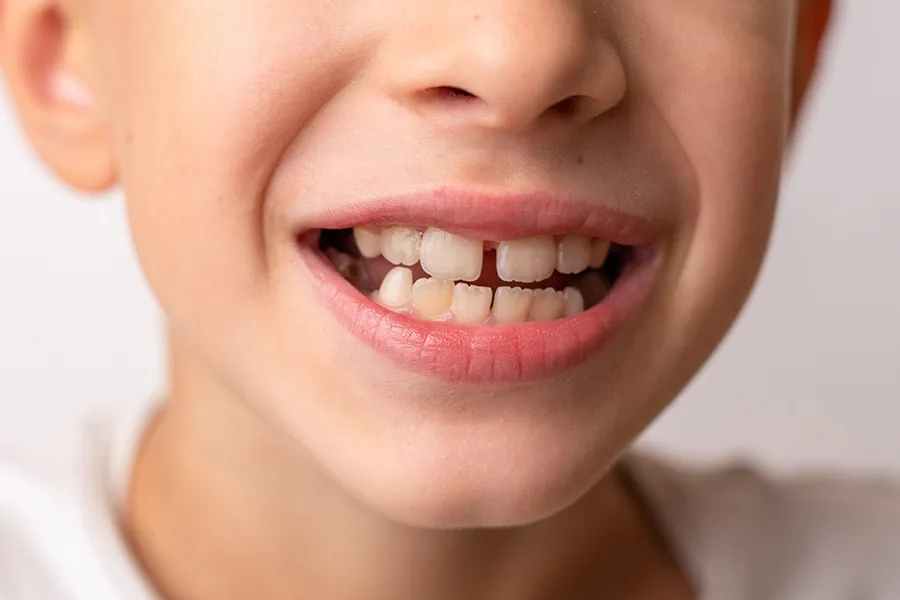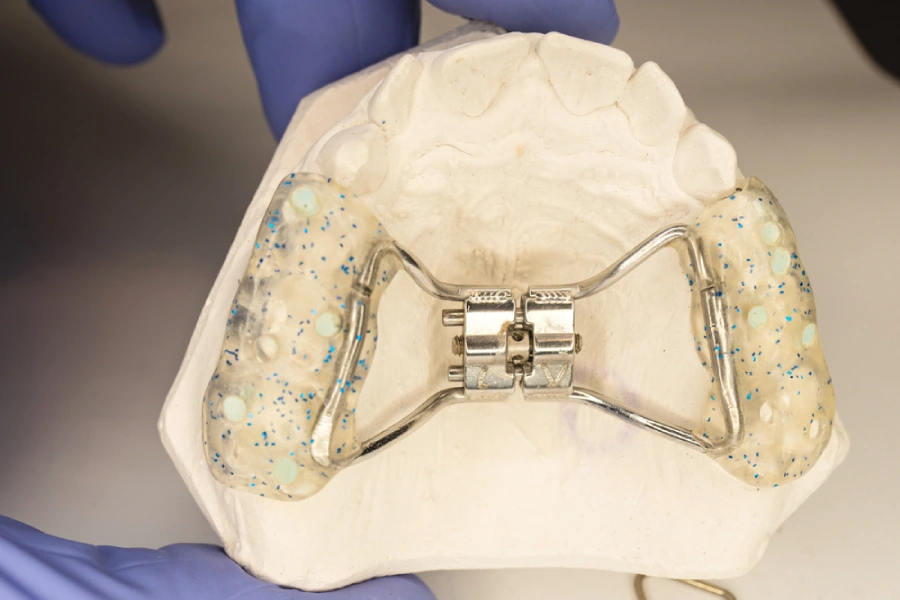Blog Summary:
Ever wondered why you or your child have gaps in your teeth? This blog post dives deep into the common and not-so-common causes of those spaces, known as diastema.
Here’s what you’ll learn:
- Why gaps in kids’ teeth aren’t always a big deal: We explore how normal development plays a role.
- The role of genetics & habits in creating gaps: It’s not just about thumb-sucking!
- The link between gum disease & gaps: Learn how oral health impacts your smile.
- How dentists fix gaps: We break down solutions like braces, cosmetic options, and more.

When you think of gaps in teeth, what comes to mind? Possibly an image of a kid, holding up a missing tooth and smiling widely. But while missing teeth can technically cause a gap, they’re not what is usually referred to as a gap in teeth, at least from a clinical perspective.
Clinically, gaps in teeth are known as “diastema”. So, what causes diastema, and is it something to be concerned about?
Below, we cover everything you need to know!
Gaps in Baby Teeth vs. Adult Teeth
Gaps in baby teeth are very common and they often close on their own when adult teeth grow in. For this reason, if your little one has a gap in their front teeth, usually, it’s not any type of cause for concern.
Gaps in adult teeth are still more common than you might think, and usually, they’re not a cause for concern, as they aren’t dangerous. However, many people find them to be uncomfortable or inconvenient because food often gets stuck in them. Just as many others wonder how they can close gap teeth because they dislike the way they look.
What’s more, while gaps due to gum disease may not be harmful themselves, gum disease itself is and must be treated.
What Causes Teeth Gaps?
Three major reasons for diastema include genetics, habits, and oral health issues. Let’s uncover more about each of these causes.
1. Genetics
Unlike other tooth problems, genetics do play a major role in teeth gaps. Many people have teeth that are too small relative to their jawbone, which causes the teeth to be spaced very far apart, resulting in gaps.
If you’re wondering what causes gaps in front teeth, there are several possible contributing factors, but one that is often genetic is an overgrowth of the tissue that borders your gum line and your two upper front teeth. If you’re wondering how to fix a gap in front teeth with this cause, typically, a type of surgery called frenectomy is required to remove the excess tissue. Most types of gaps in teeth (including front teeth) can be remedied via other means, though.
2. Habits
In kids, thumb sucking can often cause diastema, especially of the front teeth. This is because thumb-sucking puts pressure on the front teeth, causing them to shift.
Older adults can also experience tooth gaps due to a phenomenon known as tongue thrusting. When an adult thrusts their tongue, they may experience incorrect swallowing reflexes whereby the tongue pushes against the front of the teeth rather than the roof of the mouth. Like thumb sucking, this places pressure on the teeth that ultimately moves them and creates a gap.
3. Oral Health Issues
Did you know that gum disease (periodontis) can cause teeth gaps? Unfortunately, it’s true. Gum disease often starts as a result of poor oral hygiene, but it also has a hereditary factor. What’s more, conditions like diabetes, Crohn’s disease, immunodeficiency, and lack of vitamin C can also contribute to the development of gum disease.
Regardless of the cause of gum disease itself, once developed to advanced stages, it can cause the gums to pull back from the teeth, and can even cause the teeth to shift position, resulting in gaps, or even loss of teeth.
How to Fix Gaps in Teeth
The two most common remedies for gaps in teeth are orthodonture and cosmetic dentistry. For gaps in teeth caused by gum disease, as the Cleveland Clinic notes, other treatments may be necessary.
1. Orthodonture
Getting braces is the most common way to fix gaps in teeth, especially if they occur between more than two teeth. Braces slowly shift the teeth by applying pressure to them that moves them over time. At the Super Dentists, we offer a number of types of braces to work for the budgets and needs of various individuals.
2. Cosmetic Dentistry
Depending on the type of gap between teeth, it may be fixable via methods like dental bonding or applying porcelain veneers.
3. Gum Treatments
For gaps in teeth that are caused by advanced gum disease, the gum disease must be treated first before the gaps are dealt with. This may require procedures like scaling and root planing, or in more advanced cases, gingival flap surgery.
Schedule an Appointment for Gap Teeth Today
As you can see, the pesky little gaps that you might notice when you look in the mirror aren’t normally too concerning on their own from a health perspective. But gum disease is concerning and is correlated with a number of other health issues.
If you notice gaps in your teeth or your little one’s teeth and you’re looking to investigate why that is and what to do about them, we invite you to book an appointment with us at The Super Dentists now! We can help you diagnose gap teeth with a routine dental exam and devise an appropriate treatment plan given your circumstances.










